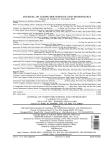版权所有:内蒙古大学图书馆 技术提供:维普资讯• 智图
内蒙古自治区呼和浩特市赛罕区大学西街235号 邮编: 010021

作者机构:School of ComputingGachon UniversitySeongnam 13120Korea School of Computer ScienceThe University of SydneySydney 2006Australia Department of Computer Science and EngineeringShanghai Jiao Tong UniversityShanghai 200240China
出 版 物:《Journal of Computer Science & Technology》 (计算机科学技术学报(英文版))
年 卷 期:2024年第39卷第2期
页 面:320-335页
核心收录:
学科分类:12[管理学] 1201[管理学-管理科学与工程(可授管理学、工学学位)]
基 金:supported by the Korea Health Technology Research and Development Project through the Korea Health Industry Development Institute under Grant No.HI22C1651 the National Research Foundation of Korea(NRF)under Grant No.2021R1F1A1059554 the Culture,Sports and Tourism Research and Development Program through the Korea Creative Content Agency Grant funded by the Ministry of Culture,Sports and Tourism of Korea under Grant No.RS-2023-00227648
主 题:data retrieval direct volume rendering ray analysis transfer function
摘 要:Direct volume rendering(DVR)is a technique that emphasizes structures of interest(SOIs)within a volume visually,while simultaneously depicting adjacent regional information,e.g.,the spatial location of a structure concerning its *** DVR,transfer function(TF)plays a key role by enabling accurate identification of SOIs interactively as well as ensuring appropriate visibility of *** generation typically involves non-intuitive trial-and-error optimization of rendering parameters,which is time-consuming and *** at mitigating this manual process have led to approaches that make use of a knowledge database consisting of pre-designed TFs by domain *** these approaches,a user navigates the knowledge database to find the most suitable pre-designed TF for their input volume to visualize the *** these approaches potentially reduce the workload to generate the TFs,they,however,require manual TF navigation of the knowledge database,as well as the likely fine tuning of the selected TF to suit the *** this work,we propose a TF design approach,CBR-TF,where we introduce a new content-based retrieval(CBR)method to automatically navigate the knowledge *** of pre-designed TFs,our knowledge database contains volumes with SOI *** an input volume,our CBR-TF approach retrieves relevant volumes(with SOI labels)from the knowledge database;the retrieved labels are then used to generate and optimize TFs of the *** approach largely reduces manual TF navigation and fine *** our CBR-TF approach,we introduce a novel volumetric image feature which includes both a local primitive intensity profile along the SOIs and regional spatial semantics available from the co-planar images to the *** the regional spatial semantics,we adopt a convolutional neural network to obtain high-level image feature *** the intensity profile,we extend the dynamic time warping technique to address subtle alignment